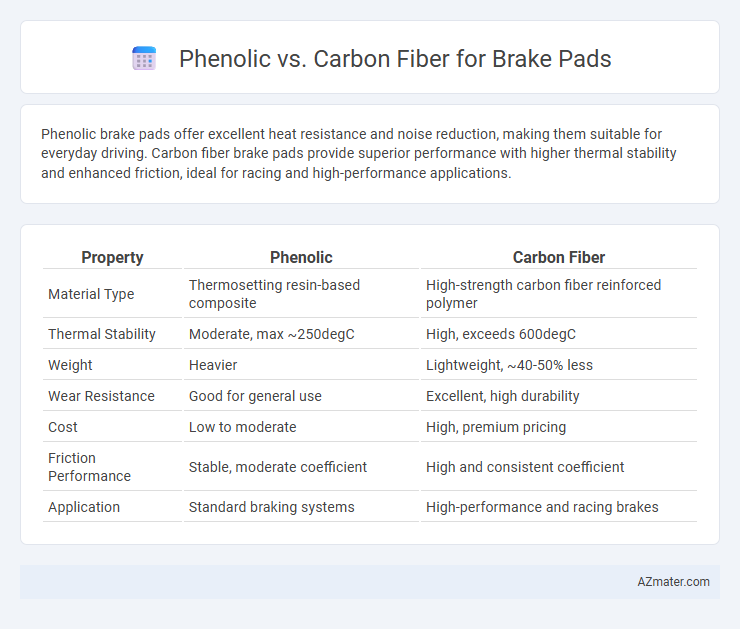Phenolic brake pads offer excellent heat resistance and noise reduction, making them suitable for everyday driving. Carbon fiber brake pads provide superior performance with higher thermal stability and enhanced friction, ideal for racing and high-performance applications.
Table of Comparison
| Property | Phenolic | Carbon Fiber |
|---|---|---|
| Material Type | Thermosetting resin-based composite | High-strength carbon fiber reinforced polymer |
| Thermal Stability | Moderate, max ~250degC | High, exceeds 600degC |
| Weight | Heavier | Lightweight, ~40-50% less |
| Wear Resistance | Good for general use | Excellent, high durability |
| Cost | Low to moderate | High, premium pricing |
| Friction Performance | Stable, moderate coefficient | High and consistent coefficient |
| Application | Standard braking systems | High-performance and racing brakes |
Introduction to Brake Pad Backing Plate Materials
Phenolic and carbon fiber are two primary materials used for brake pad backing plates, each offering distinct mechanical properties and thermal performance. Phenolic backing plates provide excellent thermal insulation and durability, helping to reduce noise and vibrations during braking. Carbon fiber plates deliver superior strength-to-weight ratio and high-temperature resistance, making them ideal for high-performance and racing brake systems.
What Are Phenolic Brake Backing Plates?
Phenolic brake backing plates are made from a composite material consisting of resin and reinforcing fibers, known for their lightweight and heat-resistant properties. Compared to carbon fiber, phenolic plates offer superior noise reduction and better vibration damping, which enhances braking comfort and performance. These plates resist corrosion and minimize heat transfer to the vehicle's hydraulic system, making them a popular choice for standard brake pads in automotive applications.
Overview of Carbon Fiber Brake Backing Plates
Carbon fiber brake backing plates offer superior strength-to-weight ratios compared to phenolic counterparts, enhancing brake system responsiveness and reducing overall vehicle weight. These composite plates exhibit excellent thermal stability and resistance to deformation under high-temperature conditions, crucial for performance and safety in demanding braking scenarios. Advanced carbon fiber materials also provide improved durability and corrosion resistance, extending the lifespan of brake components in various driving environments.
Key Performance Differences: Phenolic vs Carbon Fiber
Phenolic brake pads offer excellent heat resistance and durability, making them ideal for everyday driving by providing consistent braking performance at moderate temperatures. Carbon fiber brake pads excel in high-performance applications due to their superior thermal conductivity, lightweight structure, and enhanced friction stability at extreme temperatures. While phenolic pads generally produce less noise and dust, carbon fiber pads deliver improved braking response and longevity under aggressive driving conditions.
Heat Resistance and Thermal Management
Phenolic brake pads offer moderate heat resistance and efficient thermal dissipation suitable for daily driving, while carbon fiber pads excel in high-temperature environments due to their superior heat tolerance and thermal conductivity. Carbon fiber materials maintain structural integrity and braking performance under extreme heat, reducing fade during intense braking conditions. Phenolic pads provide quieter operation and lower wear rates but are less effective in managing heat during prolonged high-stress use compared to carbon fiber brake pads.
Weight Comparison: Phenolic vs Carbon Fiber
Carbon fiber brake pads are significantly lighter than phenolic brake pads, making them the preferred choice for high-performance and racing applications where weight reduction is critical. Phenolic brake pads are heavier due to their resin-based composition, which contributes to durability but increases overall weight. The reduced mass of carbon fiber pads improves vehicle responsiveness and handling by lowering unsprung weight.
Durability and Longevity of Each Material
Phenolic brake pads provide moderate durability with excellent heat resistance and are well-suited for everyday driving, but they tend to wear out faster under extreme conditions compared to carbon fiber. Carbon fiber brake pads offer superior longevity and exceptional durability, maintaining performance under high temperatures and heavy loads due to their high strength-to-weight ratio and thermal stability. Vehicle owners seeking long-lasting brake components typically prefer carbon fiber for its extended lifespan and consistent performance in demanding environments.
Cost Considerations and Availability
Phenolic brake pads generally offer lower production costs and wider availability due to standard manufacturing processes and common raw materials. Carbon fiber brake pads demand higher expenses linked to advanced material sourcing and specialized fabrication, limiting their accessibility. The cost-efficiency and mass-market presence of phenolic pads make them a preferred choice for everyday vehicles, while carbon fiber pads cater to high-performance applications despite their premium price and restricted supply.
Environmental Impact and Sustainability
Phenolic brake pads, made primarily from organic resins and fibers, generally have a lower environmental impact due to their biodegradable components and lower energy-intensive manufacturing processes compared to carbon fiber pads. Carbon fiber brake pads, while offering superior performance and durability, involve energy-intensive production and pose challenges for recycling, contributing to a larger carbon footprint and more persistent environmental waste. Sustainable brake pad manufacturing increasingly favors phenolic materials for their reduced ecological footprint and potential for end-of-life biodegradability.
Which Backing Plate Material Is Best for Your Vehicle?
Phenolic backing plates are lightweight, corrosion-resistant, and provide excellent noise-dampening, making them ideal for everyday driving and vehicles requiring smooth braking performance. Carbon fiber backing plates offer superior strength, heat dissipation, and reduced weight, which enhances braking efficiency and durability in high-performance or racing vehicles. Selecting the best backing plate material depends on your vehicle's usage: phenolic suits daily drivers, while carbon fiber is preferred for performance-oriented applications.

Infographic: Phenolic vs Carbon fiber for Brake pad
 azmater.com
azmater.com